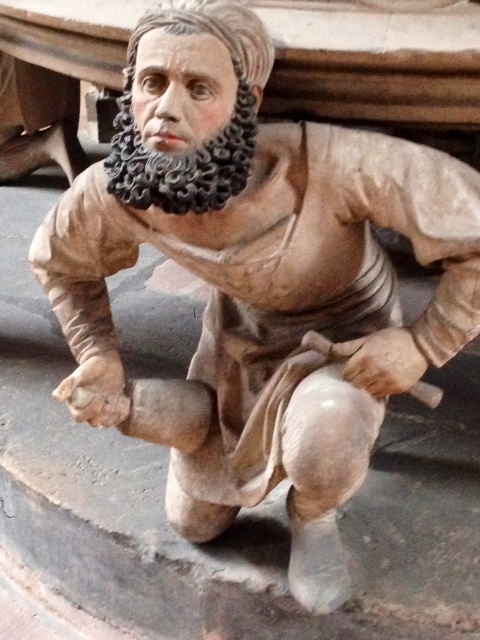Four days flew by in Nuremberg. I had come to see the Renaissance sculpture in its three main churches; St Lorenz-Kirche, Frauen-Kirche and St Sebaldus-Kirche, each barely standing at the end of 1945. Now miraculously and lovingly restored. Their treasured works of art were removed and stored in tunnels under the nearby Kaiserberg.
In St Lawrence, one work could not be moved, the incomparable, Sacrament House, by the stonemason, Adam Kraft 1493/96. Instead, a protective encasement of reinforced concrete was built to withstand the tempest, which destroyed much of its surroundings. Today, one is thankful for that providence.
This tower like edifice, stands almost twenty metres tall, and is affixed to one of the Choir Columns. Its lower section contains a tabernacle, and its surrounding balustrade is famously supported by the master himself, and two of his journeymen. Adam Kraft’s self portrait, though in bearing very different to the previously mentioned, Nicholas Gerhaert in Strasbourg, is also a remarkable representation. In Kraft’s case, his image takes a structural role in supporting the edifice above. His rendering is such that its presence enables The Sacrament House to appear to defy gravity, which is a mighty feat of illusion, given the weight of that structure.
Nurembeg, is a mature city, that has witnessed much. The Sacrament House is indicative of the highest aspirations of its humanist past. A tram ride away, another edifice testifies to the more pitiless aims of the Nationalist Socialists, not so long ago.
The remains, of Albert Speer’s vision, to make over the Zepplin Fields as the staging ground for Hitler’s highly orchestrated Nuremberg rallies, have been left in their half completed state. Now a documentation centre to the rise of National Socialism in post World War 1 Germany, this monstrous pile of brick and stones only human content, is the knowledge that those mountains of material, were quarried with the brutally forced labour of those the regime deemed, “anti social “. Many died atoning for their “sins”, every precisely cut, hand finished, block of stone, is testament to that inhumanity.
Sitting inside St Lawrence’s, drawing the Adam Kraft figure, while the church organ summoned angels in the background, was a sublime experience for me . That it could be had in this city that has born witness to the polar opposites, existing in all human beings, only added to the poignancy of that moment.
In the blog post Australian sculptor Stephen Hart explores Renaissance sculpture in Nuremberg.
 Adam Kraft. St Laurence's Church.
Nuremberg
Adam Kraft. St Laurence's Church.
Nuremberg